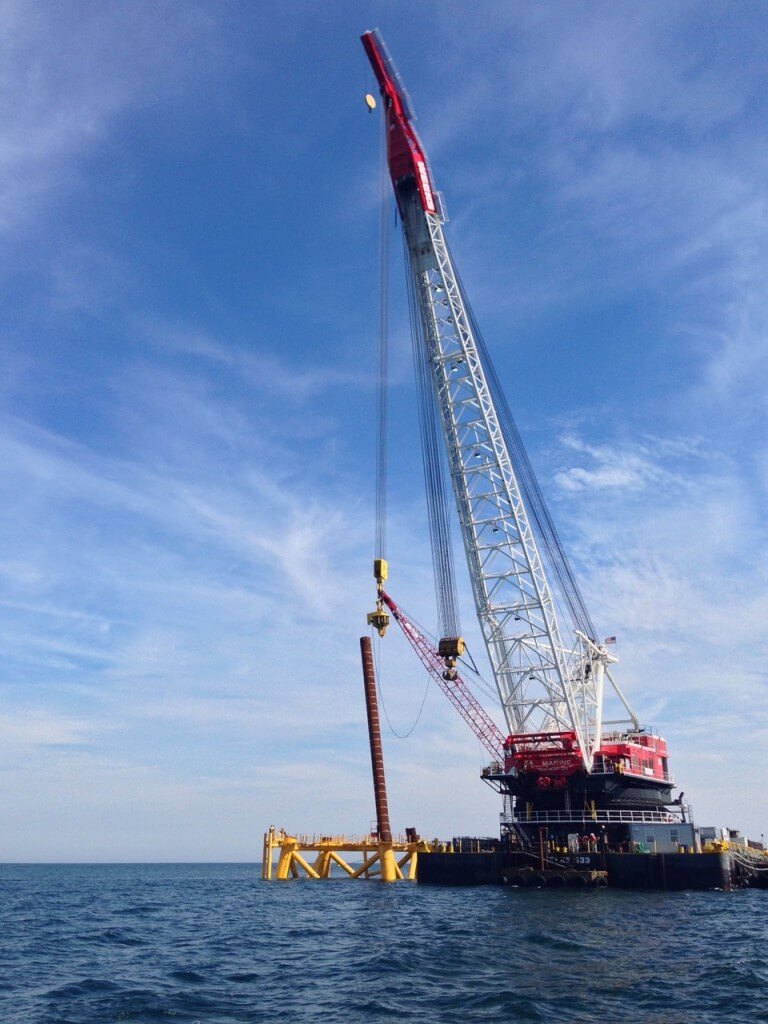Block Island is a teardrop-shaped piece of land some 13 miles off the coast of Rhode Island, U.S. Until recently, it was best known for its beaches, wind-swept bluffs and summer vacation homes. But a new attraction is quickly rising three miles off its southeastern shore.
There, in the choppy Atlantic surf, a company called Deepwater Wind started building what will be America’s first offshore wind farm. The farm will have five wind turbines, each rising to twice the height of the Statue of Liberty. When completed in late 2016, they will generate a combined 30 MW and turn Block Island into the most powerful coastal enclave in the northeast (with apologies to the Hamptons).
But there’s more to the project. It is also the physical example of GE’s future following its acquisition of Alstom’s power and grid business, which closed earlier

A jacket foundation is set for a turbine off of Block Island. The turbines will be installed Spring or summer of 2016.
The Block Island farm brings together Alstom’s massive Haliade turbines, whose blade tips will reach 600 feet above the water, and GE’s innovative gearless permanent magnet generators that can produce 6 MW. The combination has the potential to transform the renewables business in the U.S. and abroad.
Until now, Europe has been the hub of wind innovation, says Bryan Martin, head of U.S. private equity at the financial firm D.E. Shaw. The company is financing the $290 million Deepwater farm, and Martin believes that bringing Alstom’s wind turbines and GE’s power generation technology under one roof will change the wind industry’s competitive landscape. “We’re very excited about GE’s acquisition of Alstom’s power businesses,” Martin says.“GE and Alstom getting together provides the first real competitor to Siemens” for offshore wind farms in Europe, Martin says.
The rotor of each Haliade turbine is nearly one-and-a-half times the length of a football field, or 150 meters. All that torque spins GE’s 6-MW direct drive permanent magnet generator. The design lets GE engineers eliminate the gearbox, reduce the number of moving parts, cut the need for maintenance, and lower the operating cost.
The generator weighs 150 tons and will sit 100 meters in the air. It’s split into three separate electrical circuits. Even if two circuits go offline, the turbine can still produce 2 MW on the remaining circuit. Low maintenance and redundancy are hugely important, especially for offshore installations, where treacherous waters and high wind can delay a repair trip for days or weeks.
Jeffrey Grybowski, chief executive of Deepwater, says the farm will power all of Block Island, which currently relies on expensive diesel fuel. The farm will also lower carbon emissions by an estimated 40,000 tons annually. It could also help cut electricity bills for Block Island residents by up to 40%. “Offshore wind can power much of the U.S. East Coast, not least in the Northeast, where the wind is strong and we need energy,” Grybowski says. “And we can employ lots of people doing it.”

The artist’s rendering hints at the size of the Haliade turbines. Their rotors will sport 150-m diameter and each unit will be capable of generating 6 MW for a total of 30 MW.
The Block Island farm will be the first offshore wind farm in the U.S. But the potential for U.S. offshore wind energy is massive — over 4,000 gigawatts (GW), which amounts to more than four times the nation’s annual electricity production, according to the U.S. Department of Energy. President Barack Obama’s Clean Power Plan has also increased interest in onshore and offshore wind energy, presenting a new opportunity for industry.
So far, a total of 47,000 onshore turbines have been installed in the U.S. wind market, where GE is a major player. The Alstom power and grid acquisition now gives it a stronger offshore offering and also one of the broadest and deepest renewables portfolios in the industry. The combined businesses will also have expanded project expertise and financing for power projects.
“Today offshore wind is a small market with big potential, and the Block Island project sits at the leading edge of innovation,” says Anders Soe Jensen, CEO of GE’s offshore wind unit. “We’re proud that GE will again be making energy history with the first American offshore wind farm.”
The farm will have five wind turbines, each rising to twice the height of the Statue of Liberty. When completed in late 2016, they will generate a combined 30 MW.
Filed Under: Construction, News, Offshore wind




